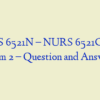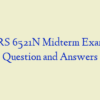Description
NURS 6521N Week 1 – Quiz
- A patient with a variety of chronic health problems is being seen by her nurse practitioner, who is currently reviewing the patient’s medication regimen. Which of the patient’s medications should prompt the nurse to teach her to avoid drinking grapefruit juice?
- The nurse is caring for a patient receiving an aminoglycoside (antibiotic) that can be nephrotoxic. Which of the following will alert the nurse that the patient may be experiencing nephrotoxicity?
- During a clinic visit, a patient complains of having frequent muscle cramps in her legs. The nurse’s assessment reveals that the patient has been taking over-the-counter laxatives for the past 7 years. The nurse informed the patient that prolonged use of laxatives
- An elderly postsurgical patient has developed postoperative pneumonia in the days following abdominal surgery and is being treated with a number of medications. Which of the following medications that the nurse will administer has the slowest absorption?
- A patient has been prescribed several drugs and fluids to be given intravenously. Before the nurse starts the intravenous administration, a priority assessment of the patient will be to note the
- A patient with a recent diagnosis of acute renal failure has a long-standing seizure disorder which has been successfully controlled for several years with antiseizure medications. The nurse should recognize that the patient’s compromised renal function will likely
- In which of the following patients would a nurse expect to experience alterations in drug metabolism?
- Talwin given in combination with Vistaril diminishes the adverse effects of nausea caused by the Talwin. This drug interaction affecting the pharmacodynamics of the Talwin is
- A patient has been receiving regular doses of an agonist for 2 weeks. Which of the following should the nurse anticipate?
- Which of the following affects drug distribution throughout the body?
- A nurse is discussing with a patient the efficacy of a drug that his physician has suggested, and he begin taking. Efficacy of a drug means which of the following?
- A 60-year-old African-American man lives with a number of chronic health problems. Genetic factors are likely to influence his etiology and/or treatment of
- A home health nurse notes that there have been changes to a patient’s oral drug regimen. The nurse will closely monitor the new drug regimen to
- For which of the following patients would a nasogastric tube most likely be considered to aid in the administration of medications?
- A nurse has been administering a drug to a patient intramuscularly (IM). The physician discontinued the IM dose and wrote an order for the drug to be given orally. The nurse notices that the oral dosage is considerably higher than the parenteral dose and understands that this due to
- A nurse is caring for a postsurgical patient who has small tortuous veins and had a difficult IV insertion. The patient is now receiving IV medications on a regular basis. What is the best nursing intervention to minimize the adverse effects of this drug therapy?
- A patient is treated with an antibiotic for an infection in his leg. After 2 days of taking the antibiotic, the patient calls the clinic and reports that he has a rash all over his body. The nurse is aware that a rash can be an adverse effect of an antibiotic and can be either a biologic, chemical, or physiologic action of the drug, which is an example of
- Tylenol 325 mg/tablet, patient needs 650 mg; how many tables should patient take?
- An older adult patient with a history of Alzheimer’s disease and numerous chronic health problems has been prescribed several medications during his current admission to hospital and recent declines in the patient’s cognition have impaired his ability to swallow pills. Which of the following medications may the nurse crush before administering them to this patient?
- A nurse is caring for a patient who has had part of her small intestine removed due to cancer. She has also now developed hypertension and has been prescribed a new medication to decrease her blood pressure. While planning the patient’s care, the nurse should consider a possible alteration in which of the following aspects of pharmacokinetics?
- On the 1 a.m. rounds, the nurse finds a patient awake and frustrated that she cannot go to sleep. The nurse administers an ordered hypnotic to help the patient sleep. Two hours later, the nurse finds the patient out of bed, full of energy and cleaning her room. The nurse evaluates the patient’s response to the hypnotic as
- 5 ml = _______________tsp
- A nurse is instructing a patient concerning a newly prescribed drug. Which of the following should be included to help improve patient compliance and safety?
- A patient has been prescribed an oral drug that is known to have a high first-pass effect. Which of the following measures has the potential to increase the amount of the free drug that is available to body cells?
- Which of the following statements best defines how a chemical becomes termed a drug?
- A 70-year-old man who enjoys good health began taking low-dose aspirin several months ago based on recommendations that he read in a magazine article. During the man’s most recent visit to his care provider, routine blood work was ordered and the results indicated an unprecedented rise in the man’s serum creatinine and blood urea nitrogen (BUN) levels. How should a nurse best interpret these findings?
- Mr. Lacuna is an 83-year-old resident of a long-term care facility who has a diagnosis of moderate Alzheimer’s disease. Mr. Lacuna’s physician recently prescribed oral rivastigmine, but he was unable to tolerate the drug due to its gastrointestinal effects. As a result, he has been ordered the transdermal patch form of the medication. When administering this form of rivastigmine, the nurse should
- Mrs. Houston is a 78-year-old woman who resides in an assisted living facility. Her doctor prescribed digoxin at her last visit to the clinic and she has approached the nurse who makes regular visits to the assisted-living facility about this new drug. What teaching point should the nurse emphasize to Mrs. Houston?
- A 79-year-old woman has been admitted to the hospital with a gastrointestinal bleed. She is currently receiving a transfusion of packed red blood cells as well as an infusion of pantoprazole (Protonix), a proton-pump inhibitor, to help stop her bleeding. What care setting is most appropriate for this patient?
- A 77-year-old woman who is 5 feet 3 inches tall and weighs 89 lbs has been admitted to the hospital with a diagnosis of failure to thrive.
- What action should the nurse prioritize when addressing the woman’s apparent lack of nutrition?
- A nurse who provides care for older adults is aware of the high incidence of drug interactions in this population. When educating a group of seniors about the prevention of drug interactions, the nurse should encourage them to
- A 75-year-old woman is prescribed magnesium hydroxide for constipation. The nurse’s assessment reveals that the patient is being treated for rheumatoid arthritis and hypertension. The patient lives in assisted living and is on a low-sodium diet. Before the magnesium hydroxide therapy begins, it will be most important for the nurse to assess the patient’s
- A nurse is caring for a 70-year-old patient who is taking desmopressin (DDAVP). The patient has a history of cardiovascular disease. The nurse will prioritize the assessment of which of the following?
- An 80-year-old patient has been taking lorazepam since his wife died a year ago. He has been staying with his son, but will now move to an assisted living facility. Before admission to the assisted living facility, the patient’s physician has determined that the drug is no longer needed. The nurse at the facility will plan to
- Mr. Nguyen, age 71, will soon be discharged home from the hospital after a successful coronary artery bypass graft (CABG). During patient education about his drug regimen, Mr. Nguyen’s nurse should prioritize teaching about
- A 77-year-old man with a long history of absence seizures has been treated with ethosuximide for many years.
- The man is now in the process of moving to a long-term care facility and a nurse is creating a plan of care.
- The nurse understands the potential adverse effects of this drug and would consequently prioritize which of the following nursing diagnoses?
- A 79-year-old woman with a medical history that includes osteoporosis has recently moved to a long-term care facility. Medication reconciliation indicates that the woman has been taking calcitonin, and salmon for several years. The nurse should recognize that the most likely route for the administration of this drug is
- A community health nurse is performing a home visit to an elderly client who receives twice-weekly wound care. The client has mentioned that she has been having difficulty sleeping, a problem that she has not previously experienced. Which of the following measures should the nurse suggest?
- A 79-year-old woman who takes several medications for a variety of chronic health problems has been prescribed an oral antiplatelet aggregator that is to be taken once daily. The nurse has encouraged the woman to take the pill at the same time of day that she takes some of her other medications. What is the most likely rationale for the nurse’s advice?
- An 80-year-old man has been prescribed oxycodone for severe, noncancer, chronic pain. He tells the nurse that he has difficulty swallowing and asks if he can crush the tablet before swallowing. The nurse will advise the patient that
- So, check out our latest Tutorials and Courses on BUSI 435.























